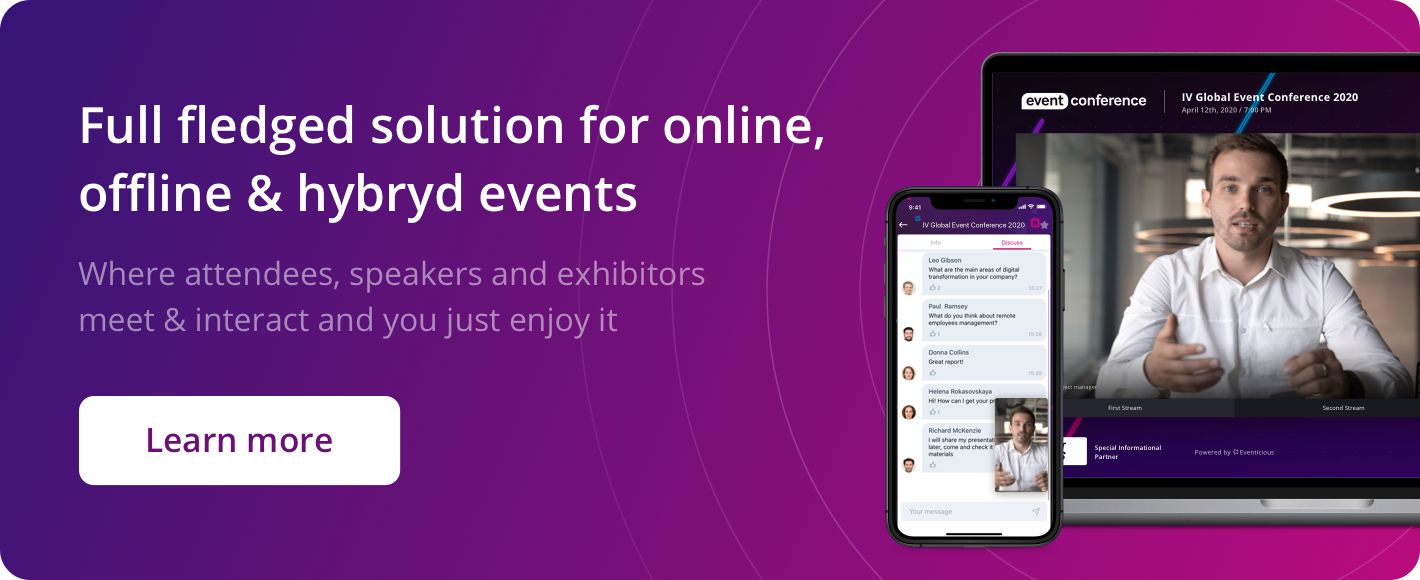Gamification is using game-based mechanics to motivate and engage event participants. In other words, with the help of a mobile application, an official event can be transformed into a game. The Eventicious team is constantly looking for new useful features and services and incorporating them into our apps to provide a high-quality support for any event. In this case study we will find out how gamification can help draw as many as 102% of event attendees into activities. The event we’ll be looking into was held by a large bank that kindly allowed us to share this experience, but preferred to remain anonymous.
This is how it works:
When people use certain application features, e.g. schedule meetings, communicate in the chat, complete their profiles, etc., they are awarded bonus points. The more actively they use the application, the more points they get. Points can be awarded for any activity, it’s up to you to decide. This way, you, as the event organizer, can promote certain activities at your event.
Here are just a few examples:
- Participating in polls and quizzes
- Posting in social networks or in the internal chat
- Scheduling business meetings
- Rating presentations
- The number of asked questions
- Registering for the event, and many others
Attendees are rated depending on how many points they have earned. Those with the highest rating get valuable prizes. The number and value of prizes are also at the discretion of event organizers. In our experience, prizes ranged from branded glasses to a trip to Rome. Naturally, the more attractive are the prizes, the more motivated are the participants.
Achieving a high rating is by no means an end in itself, but it motivates attendees to actively use the application, to communicate and to express themselves. As a result, they have a more rewarding experience at the event.
However, just adding gamification to the application won’t do the trick: a good informational support is also needed. This task falls on event organizers: they need to conduct a small PR-campaign for the application to explain what it can do and how it can be used, what game features it has and how to use them, and, most importantly, what prizes will be awarded.
An unusual use of gamification
Gamification can be even more fun if the “game” extends into the environment.
For example, you could use iBeacons, which are radio beacons that can be detected by smartphones. They can be placed anywhere around the event venue: in rooms, conference halls, even outside. Once you reach a control point, your phone detects the beacon and you receive award points.
Another alternative to iBeacons are good old QR codes. In this case, the use scenario will be a bit different: when you come to a control point and perform a certain action, an animator will scan your QR code displayed in the application and you will get award points that can be used, for example, in the bar to get a special cocktail.Modern technology makes it possible to implement many unusual gamification scenarios, such as a treasure hunt using a map with riddles, secret messages, etc.
Case study: corporate training event of N Bank Corporate University
Task
The N Bank Corporate University offers a Mini BMA program, and its 4th stream was scheduled for April 17-21. The program is targeted at line managers and strives to empower them with skills and knowledge they need to efficiently perform their jobs in accordance with the Bank Strategy and corporate competence model; it is also designed to motivate them for continuous learning.
Solution
For the first training module that was delivered on-site, the organizers used the mobile application to engage and motivate their audience to participate in activities and networking. The module lasted for 6 days and was attended by 300 N Bank managers from more than 60 cities.
During the first week, the trainees attend on-site training sessions that include presentations by invited speakers and lecturers, participate in master classes and work on team projects. Since the number of trainees is rather high, they are split into large study groups (up to 50 people each) to make the learning process more efficient and enable better interaction and communication. Trainees are also split into mini groups for individual and project work.
When organizing learning process at events with many attendees, it is very important to build effective communication, and the best way to do that is to use a multifunctional mobile application.
The application made it possible to easily make any last-moment changes in the schedule, send timely notifications to program participants, collect feedback on various activities, use gamification and enhance networking: each and any of the 300 participants could view any other participant’s calendar in the app and request a business or personal meeting.
Also, the application made it possible to arrange all information required for program logistics in a structured and easily accessible way (a list of program participants, transfers schedule, contact lists, services, etc.)
Result
The mobile application was installed by 102% of program participants. Why is this number greater than 100%? That’s because some people installed the application on more than one device, for example, on their tablet device in addition to their phone. Obviously, the number of installations was mostly determined by the fact that the app was a requirement for the on-site training program. Gamification, on the other hand, was the factor that stimulated people to actually use the app, and do it more actively.
Here are some app usage stats for the on-site training module of N Bank Mini-MBA program:
- 3,741 answered poll questions
- 983 scheduled meetings
- 4,707 chat messages
- 66,696 times the schedule was viewed
- 70 feedback questions



